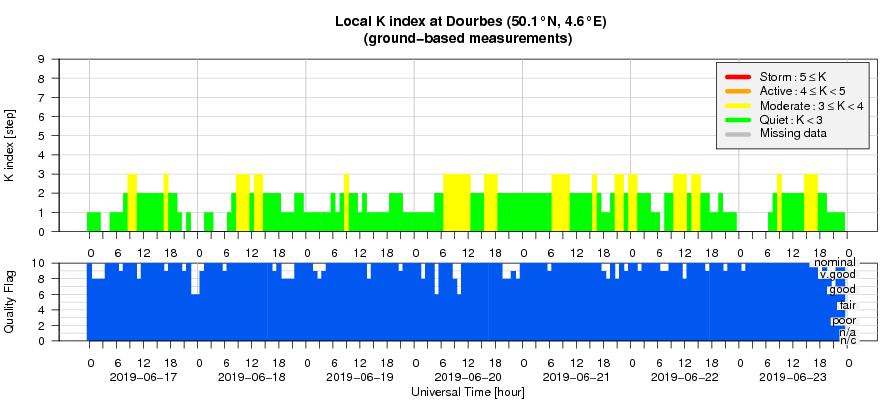- Table of Content
- 1.PROBA2 Observa...
- 2.Review of sola...
- 3.The SIDC space...
- 4.The Internatio...
- 5.Geomagnetic Ob...
- 6.Review of iono...
2. Review of solar and geomagnetic activity
3. The SIDC space weather Briefing
4. The International Sunspot Number by SILSO
5. Geomagnetic Observations at Dourbes (17 Jun 2019 - 23 Jun 2019)
6. Review of ionospheric activity (17 Jun 2019 - 23 Jun 2019)
PROBA2 Observations (17 Jun 2019 - 23 Jun 2019)
Solar Activity
Solar flare activity was very low during the week.
In order to view the activity of this week in more detail, we suggest to go to the following website from which all the daily (normal and difference) movies can be accessed: http://proba2.oma.be/ssa
This page also lists the recorded flaring events.
A weekly overview movie can be found here (SWAP week 482): http://proba2.oma.be/swap/data/mpg/movies/weekly_movies/weekly_movie_2019_06_17.mp4
Details about some of this week's events, can be found further below.
If any of the linked movies are unavailable they can be found in the P2SC movie repository here: http://proba2.oma.be/swap/data/mpg/movies/
Sunday Jun 23
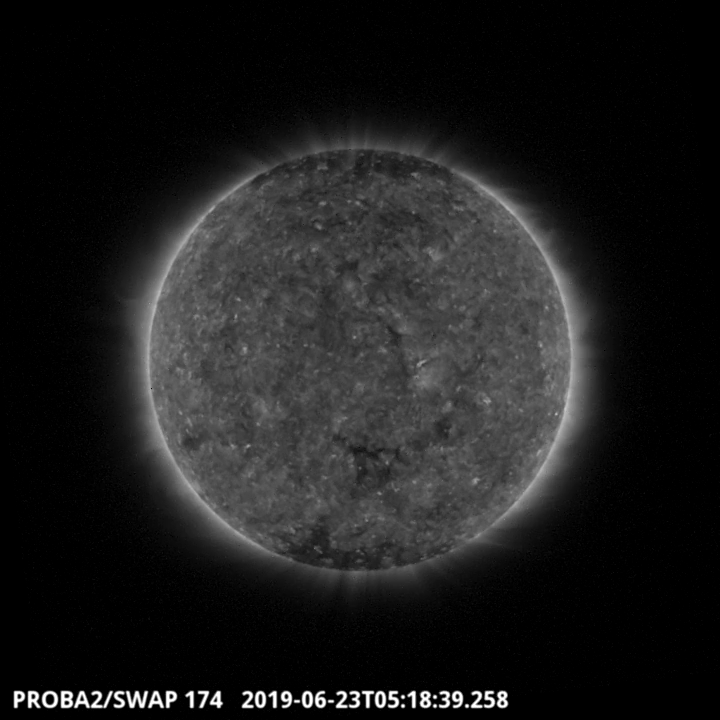
A fragmented coronal hole is visible in the SWAP image above from 2019-Jun-23. It was visible on the Sun disc since 2019-Jun-23. Find a movie of the events here (SWAP movie): http://proba2.oma.be/swap/data/mpg/movies/20190623_swap_movie.mp4
Review of solar and geomagnetic activity
SOLAR ACTIVITY
Solar activity was at very low levels.
No flares were recorded and the solar disk was spotless.
No Earth-directed coronal mass ejections (CMEs) were observed in LASCO data.
The greater than 10 MeV proton flux was at background levels.
GEOMAGNETIC ACTIVITY
Solar wind parameters were at background levels for most of the week. There was a slight enhancement of the solar wind speed in the middle of the week, with a maximum of 430 km/s recorded on June 22 (DSCOVR), before decreasing to remain below 400 km/s for the rest of the week. The total magnetic field strength reached a maximum of around 9 nT on June 21. The Bz component ranged between approximately -7 and +9 nT over the week.
The geomagnetic conditions were quiet to unsettled over the week. The local K index (Dourbes) the planetary K index (NOAA) both ranged between 0-3.
The SIDC space weather Briefing
The Space Weather Briefing presented by the forecaster on duty from June 17 to 23. It reflects in images and graphs what is written in the Solar and Geomagnetic Activity report.
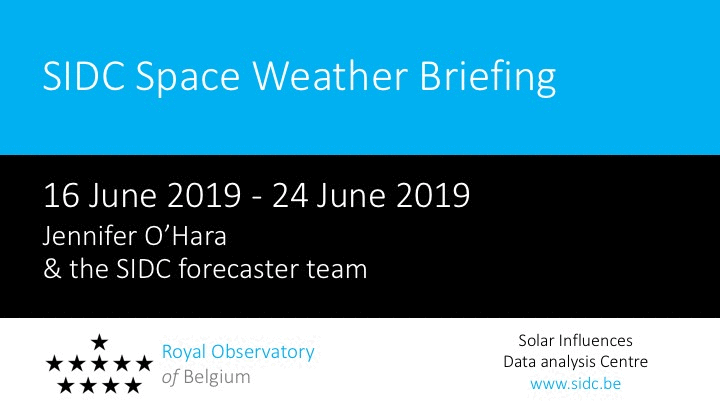
The pdf-version: http://www.stce.be/briefings/SWbriefing_20190624.pdf
The automatically running presentation: http://www.stce.be/briefings/SWbriefing_20190624.ppsm
The International Sunspot Number by SILSO
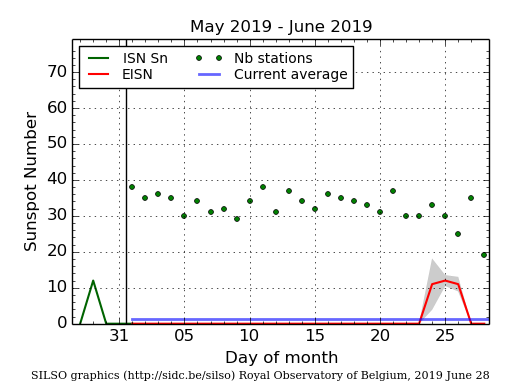
The daily Estimated International Sunspot Number (EISN, red curve with shaded error) derived by a simplified method from real-time data from the worldwide SILSO network. It extends the official Sunspot Number from the full processing of the preceding month (green line). The plot shows the last 30 days (about one solar rotation). The horizontal blue line shows the current monthly average, while the green dots give the number of stations included in the calculation of the EISN for each day.
Review of ionospheric activity (17 Jun 2019 - 23 Jun 2019)
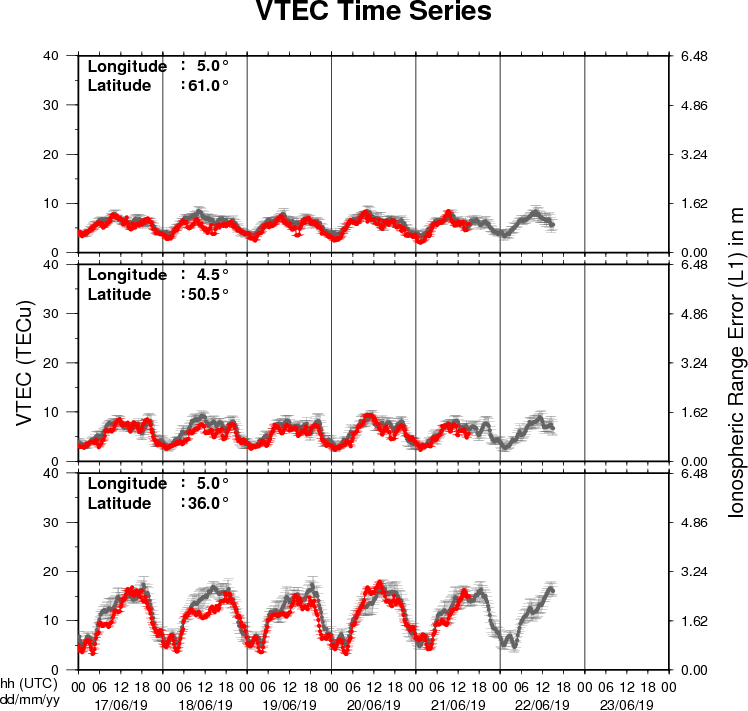
The figure shows the time evolution of the Vertical Total Electron Content (VTEC) (in red) during the last week at three locations:
a) in the northern part of Europe(N61°, 5°E)
b) above Brussels(N50.5°, 4.5°E)
c) in the southern part of Europe(N36°, 5°E)
This figure also shows (in grey) the normal ionospheric behaviour expected based on the median VTEC from the 15 previous days.
The VTEC is expressed in TECu (with TECu=10^16 electrons per square meter) and is directly related to the signal propagation delay due to the ionosphere (in figure: delay on GPS L1 frequency).
The Sun's radiation ionizes the Earth's upper atmosphere, the ionosphere, located from about 60km to 1000km above the Earth's surface.The ionization process in the ionosphere produces ions and free electrons. These electrons perturb the propagation of the GNSS (Global Navigation Satellite System) signals by inducing a so-called ionospheric delay.
See http://stce.be/newsletter/GNSS_final.pdf for some more explanations ; for detailed information, see http://gnss.be/ionosphere_tutorial.php
